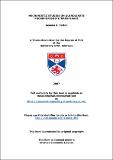Files in this item
Mechanistic studies on quinolinate phosphoribosyltransferase
Item metadata
| dc.contributor.advisor | Botting, Nigel P. | |
| dc.contributor.author | Catton, Gemma Rachel | |
| dc.coverage.spatial | 297 | en |
| dc.date.accessioned | 2008-05-15T10:52:59Z | |
| dc.date.available | 2008-05-15T10:52:59Z | |
| dc.date.issued | 2008-06 | |
| dc.identifier | uk.bl.ethos.552067 | |
| dc.identifier.uri | https://hdl.handle.net/10023/485 | |
| dc.description.abstract | Quinolinate phosphoribosyltransferase (QPRTase, EC 2.4.2.19) is an intriguing enzyme which appears to catalyse two distinct chemical reactions; transfer of a phosphoribosyl moiety from 5-phosphoribosyl-1-pyrophosphate to the nitrogen of quinolinic acid and decarboxylation at the 2-position to give nicotinic acid mononucleotide. The chemical mechanism of QPRTase is not fully understood. In particular, enzymatic involvement in the decarboxylation step is yet to be conclusively proven. QPRTase is neurologically important as it degrades the potent neurotoxin, quinolinic acid, implicated in diseases such as Huntington’s disease and AIDS related dementia. Due to its neurological importance and unusual chemistry the mechanism of QPRTase is important. Described here is a mechanistic study on human brain QPRTase. Human brain QPRTase was successfully expressed in E. coli BL21 (DE3) from the pEHISTEV-QPRTase construct and the protein was efficiently purified by nickel affinity chromatography. The crystal structure was solved using multiwavelength methods to a resolution of 1.9 Å. Human brain QPRTase was found to adopt an energetically stable hexameric arrangement. The enzyme was also found to exist as a hexamer during gel filtration under physiological conditions. Kinetic studies allowed the measurement of the kinetic parameters for quinolinic acid. The data gave a Km of 13.4 ± 1.0 μM and a Vmax of 0.92 ± 0.01 μM min-1. There was no evidence for cooperative binding of quinolinic acid to the six subunits of the QPRTase hexamer. The enzyme showed maximum activity at approximately pH 6. The active site of human brain QPRTase is a deep pocket with a highly positive electrostatic surface composed of three arginine residues, two lysine residues and one histidine residue. Mutation of these residues resulted in either complete loss or significant reduction in enzymatic activity showing they are important for binding and/or catalysis. A possible mechanism involving QPRTase in the decarboxylation of quinolinic acid mononucleotide was proposed. A series of quinolinic acid analogues were synthesised and tested as inhibitors of QPRTase. The inhibition studies highlighted some key interactions in the active site. | en |
| dc.format.extent | 2675 bytes | |
| dc.format.mimetype | application/pdf | |
| dc.language.iso | en | en |
| dc.publisher | University of St Andrews | |
| dc.rights | Creative Commons Attribution 3.0 Unported | |
| dc.rights.uri | http://creativecommons.org/licenses/by/3.0/ | |
| dc.subject | Quinolinic acid | en |
| dc.subject | Quinolinate phosphoribosyltransferase | en |
| dc.subject | Phosphoribosyl transfer | en |
| dc.subject | Decarboxylation | en |
| dc.subject | Inhibition studies | en |
| dc.subject | Site-directed mutagenesis | en |
| dc.subject.lcc | QP606.P55C2 | |
| dc.subject.lcsh | Phosphotransferases | en |
| dc.subject.lcsh | Phosphotransferases--Mechanism of action | en |
| dc.subject.lcsh | Quinolinic acid | en |
| dc.subject.lcsh | Decarboxylation | en |
| dc.subject.lcsh | Neurochemistry | en |
| dc.title | Mechanistic studies on quinolinate phosphoribosyltransferase | en |
| dc.type | Thesis | en |
| dc.type.qualificationlevel | Doctoral | en |
| dc.type.qualificationname | PhD Doctor of Philosophy | en |
| dc.publisher.institution | The University of St Andrews | en |
This item appears in the following Collection(s)
Except where otherwise noted within the work, this item's licence for re-use is described as Creative Commons Attribution 3.0 Unported
Items in the St Andrews Research Repository are protected by copyright, with all rights reserved, unless otherwise indicated.


